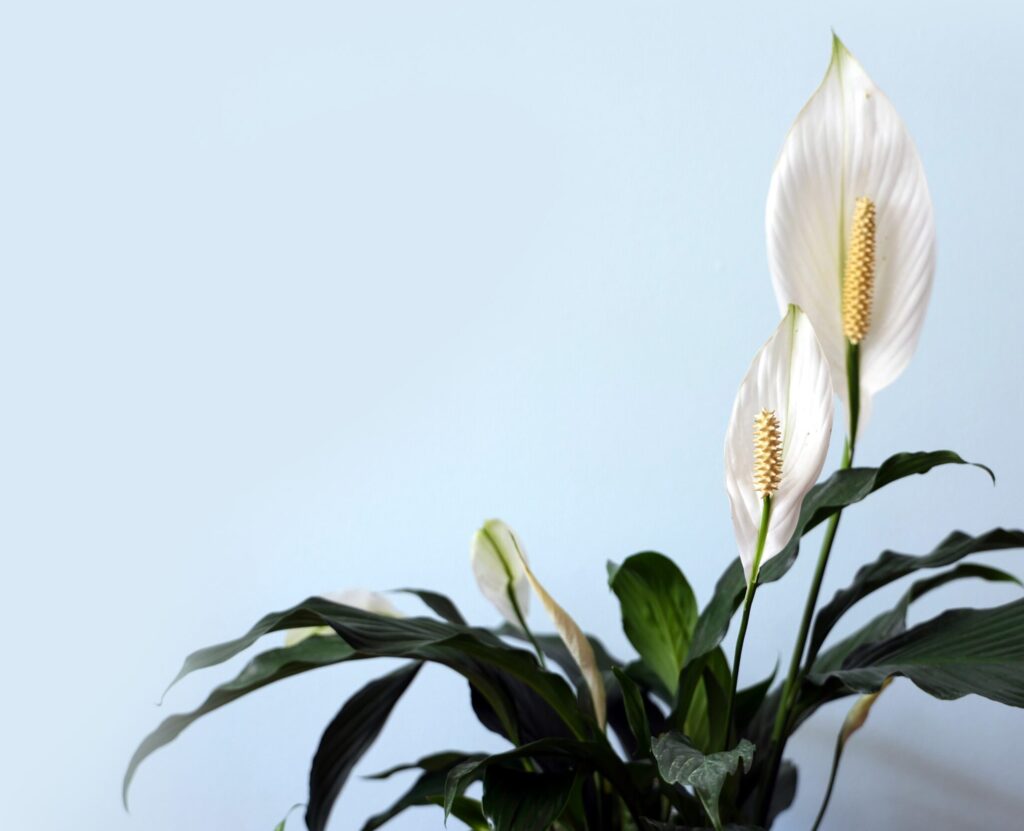
Houseplants not only add a touch of greenery to your living space but also offer numerous health and wellness benefits. Among the many indoor plants available, the Peace Lily (Spathiphyllum) stands out as a symbol of tranquility and elegance. With its lush, dark green leaves and striking white flowers, this plant is visually appealing but is also popular for its air-purifying qualities. In this blog, we’ll explore the world of Peace Lilies, including their care requirements and how to keep them thriving in your home.
Aspect | Details |
Scientific Name | Spathiphyllum spp. |
Common Name | Peace Lily |
Origin | Native to South and Central American tropical rainforests |
Toxicity | Mildly toxic |
Air Purification | Excellent; removes formaldehyde, benzene, and ammonia |
Light | Bright, indirect light; avoid direct sunlight |
Temperature | 65-80°F (18-27°C); avoid drafts and temperature extremes |
Watering | Keep soil evenly moist but not waterlogged; allow the top inch of soil to dry before watering |
Humidity | Prefers moderate to high humidity; mist leaves or use a humidity tray |
Fertilization | During growing season apply liquid fertilizer every 6-8 weeks |
Table of Contents
ToggleGetting to Know the Peace Lily
Native to the tropical rainforests of Central and South America, Peace Lilies have become a popular choice for indoor plant enthusiasts worldwide. They are well-loved for their charming appearance and their ability to thrive in low-light conditions. Here are some key characteristics of Peace Lilies:
Appearance
Peace Lilies are known for their glossy, lance-shaped leaves that arch gracefully. The most distinctive feature is their elegant white, sail-like flowers, which give the plant a serene, almost ethereal quality.
Air Purification
Peace Lilies are exceptional air purifiers. They can remove common indoor pollutants like formaldehyde, benzene, and ammonia from the air, making them a great addition to any room.
Size
These plants can range in size from small tabletop varieties to larger floor plants, depending on the specific cultivar.
Toxicity
Peace Lilies carry a mild level of toxicity. They contain calcium oxalate in all parts of the plant, which can lead to stomach discomfort and respiratory irritation if consumed in substantial quantities. It’s advisable to place Peace Lilies out of the reach of children and pets to prevent any potential chewing or ingestion of the plant.
Peace Lily Care Tips
Light Requirements:
Peace Lilies prefer bright, indirect light. Direct sunlight can scorch leaves so, avoid it. They can tolerate low-light conditions, making them ideal for spaces with limited natural light.
Temperature:
Keep your Peace Lily in a room with a consistent temperature between 65-80°F (18-27°C). Avoid placing them near drafts or heaters, as they are sensitive to temperature fluctuations.
Watering:
Maintain evenly moist soil for your Peace Lily, but be cautious not to overwater. Before watering the plant allow top soil layer to dry. Yellowing leaves can be a sign of overwatering, while drooping leaves indicate it needs water.
Humidity:
Peace Lilies thrive in humid conditions. To increase humidity, you can mist the plant regularly or place it on a tray filled with water and pebbles. Plants can also be grouped together to create a humid atmosphere.
Fertilizing:
Fertilize during the growing season (summer and spring), with a balanced liquid fertilizer every 6-8 weeks. During the winter months when plants are dormant, cut back on or stop feeding.
Repotting:
Peace Lilies don’t require frequent repotting, actually it works better when it is root bounded. Repot when you notice the plant becoming root-bound, typically every 2-3 years. Select a pot that is slightly bigger and has good drainage.
Pruning:
Trim yellow or dead leaves to boost new growth and maintain the plant’s appearance.
Propagation:
To propagate a Peace Lily, gently divide the mature plant, ensuring each section has roots and leaves. Repot them in fresh soil, water thoroughly, and place in indirect light. With care, these divisions will flourish into new thriving Peace Lilies.
Pest Control:
Keep an eye out for pests like mealy bugs and scales. Regularly inspect your Peace Lily’s leaves and treat any infestations promptly with neem oil or insecticidal soap.
Common Peace Lily Issues and Solutions
Yellow Leaves:
This can be due to overwatering, underwatering, or exposure to direct sunlight. Adjust your watering routine and relocate the plant to a suitable spot.
Brown Tips on Leaves:
Dry air or fluoride in tap water can cause brown leaf tips. Consider using distilled or filtered water, and increase the humidity.
Peace lily Not Flowering:
If your Peace Lily isn’t blooming, it might be due to insufficient light or incorrect fertilization. Provide more indirect light and ensure you’re fertilizing appropriately.
Conclusion:
In conclusion, the Peace Lily is not just a stunning addition to your home decor but also a natural air purifier that promotes a peaceful and healthy living environment. By following these care tips and providing the right conditions, you can enjoy the beauty of this remarkable plant for years to come. Whether you’re a seasoned plant enthusiast or a beginner, the Peace Lily is a perfect choice for anyone looking to bring a touch of serenity to their home.
Sources:
- https://www.almanac.com/plant/peace-lilies
- https://www.gardeningknowhow.com/houseplants/peace-lily/peace-lily-plants.htm
